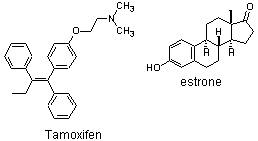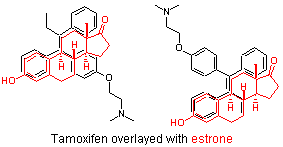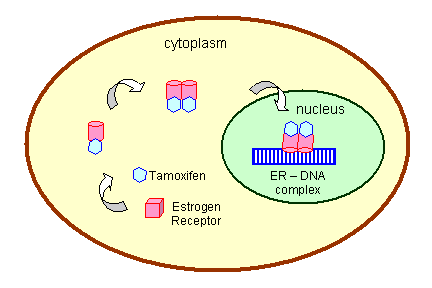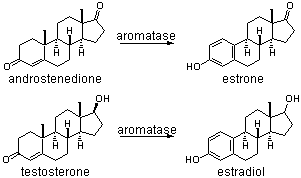
Breast cancers are often stimulated by the female hormones estrone and estradiol. In 1896 Beatson demonstrated that the removal of breast cancer patients' ovaries, a major site of production of these hormones, was beneficial. Treatment of hormone sensitive breast cancer is now uses drugs that either:
The most widely prescribed anti-cancer drug in the world is
tamoxifen.

Tamoxifen mimics the action of estrone and binds to the steroid hormone receptor protein or oestrogen receptor (ER).

The ER protein with tamoxifen bound adopts a different conformation to the one seen with estrone bound. The tamoxifen-ER complex then dimerises and is transported from the cytosol into the cell's nucleus. The dimeric tamoxifen-ER complex binds to DNA to form a new complex which is unable to function in the same way as the estrone-ER complex. The overall effect on the cells is cytostatic as the hormonal growth signal has been turned off. Breast cancer cells treated with tamoxifen stop growing at the point between the G1 and S-phases of the cell cycle.

Tamoxifen is a very effective drug when combined with surgery and radiotherapy and has contributed to an increase in survival for breast cancer patients. The low toxicity and effectiveness of tamoxifen have led to it being investigated as a chemopreventative agent for women with an increased genetic risk of developing breast cancer.
Aromatase is a cytochrome P450 heme containing enzyme which is responsible for the biosynthesis of oestrogens. The enzyme converts the androgens (male hormones) androstenedione and testosterone into estrone and estradiol, respectively.

Aminoglutethimide was introduced in 1981 for the treatment of women whos treatment with tamoxifen had failed. The drug lacked potency (IC50 = 2970 nM) and the high doses required produced side effects. The search for more potent and specific inhibitors of aromatase has led to the discovery of a number of possible drugs. Anastrozole (IC50 = 14.6 nM) has recently been licenced for the treatment of breast cancer for tamoxifen relapsed patients. Eventually it may replace tamoxifen as the drug of choice for hormone responsive disease.
